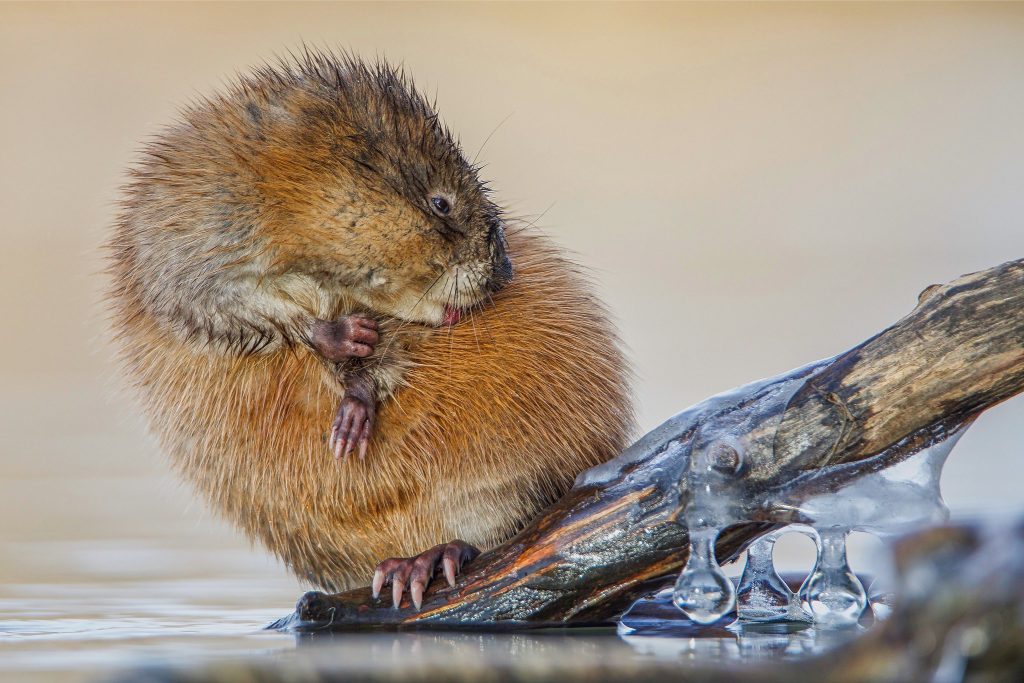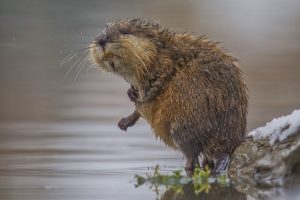Muskrats Up Close

By Tony LePrieur
As an amateur wildlife photographer, I’ve been taking pictures in Calgary and the surrounding area for the last 10 years. For me, observing and photographing wildlife is a great joy. It’s amazing just how much is out there for us to explore. I still have much to learn, but I am getting better thanks to a supportive community and publications like this one.
Although my subjects vary greatly, I do have a particular favourite: the muskrat. Why muskrats? That’s a very good question and one I’m not sure I can answer completely. At first, it had to do with opportunity. Muskrats just happened to be something I could find relatively easily. In time, after spending more and more hours with this cutest of water rodents, my appreciation grew. They are plenty interesting swimming in the water, but it’s when they come out of the water that their personality shines. I’ve been fortunate to witness a lot of different activities over the years: newborn young being moved to their new home, fights between adults, play between adults in better moods, adults making more muskrats (in MUCH better moods), and feeding on everything from a single blade of grass to a very large fish. But the most delightful has to be watching a muskrat go through its thorough grooming regimen. Their fastidious grooming routine helps keep their pelt water repellant and warm.
What I have learned on my muskrat photography expeditions is that keeping still is key. As long as you don't move, they will largely ignore you. This approach has led to several notable encounters.
On one recent outing, I was photographing late in the day and was in a position where the sun was directly in front of me. The glare off the water made it almost impossible to get a usable shot. I was able to get around this by getting very low — as in, almost needing a snorkel low. I was grasping a rock trying to keep the rest of me above water. It turns out this particular rock was the local muskrat’s favorite eating spot and it decided to climb up and enjoy its mouthful of snacks. We were both very surprised by the unexpected handshake and ended up in the water — a natural location for one of us. The muskrat tried to climb back onto the rock two more times before giving up and moving on to one without a soggy photographer attached.
Another time, I went to Frank Lake, south of Calgary, to kill some time while I waited for evening and a chance to photograph some beavers at a nearby location. My plan was to watch the ground squirrels who were active at that time and are always fun to observe. Just as I got close to one, I noticed a muskrat down by the water, fast asleep. I got into my ideal picture-taking position — laying in the mud — and decided to quietly wait for it to wake up, knowing I could get a good shot when it did. In hindsight I wish I had selected a drier spot, because that mud became my base of operations for the next three and a half hours. I soon discovered this muskrat had a schedule it followed: sleep for 30 minutes, go for a short swim, do some grooming, and then back to the grass to start the process all over again. I watched it do this three times and on the fourth run-through it changed things up and went fishing instead. I knew muskrats sometimes eat fish, but getting to watch one do it a few feet in front of me was pretty amazing. I watched it catch and eat a small fish and then move on to a dead one on the shore. When it finished its meal, it decided to check out the big lump in the mud: me. I watched through my camera lens as it kept getting closer and closer, and before I knew it, it was climbing into the lens hood of my camera — the ultimate closeup! It explored that for a bit and then came around for a face-to-face. No exaggeration here, it was inches from my face and brushing against my arm. It just looked at me for a few seconds, then slowly waddled about two feet away, curled up in a ball and went to sleep, back on its schedule. It was the coolest experience ever. Not so good for picture taking though, as most of the encounter happened way too close for me to be able to focus.
I spend so much time photographing muskrats that my method has become somewhat refined. I’m far from being an expert, but I have learned a few things that may help you with your muskrat photographic adventures:

Muskrat by Tony Leprieur
Tip 1: It’s always best to photograph wildlife at eye level, so for muskrats this will mean getting a bit wet and dirty. You will want to dress appropriately.
Tip 2: Don’t let them see you move. Muskrats can be a bit skittish but seem to be a lot more tolerant of the human presence if you remain completely still. Much of their food gathering takes place underwater, so you can move when they dive. Just make sure you freeze before they resurface.
Tip 3: As with all wildlife photography, capturing muskrats requires patience. If you are not moving, muskrats will likely be calm and will simply go about their day. Muskrat days are not always exciting but if you wait long enough something interesting is sure to turn up.
There is so much out there to see and experience. I wish you all the best capturing your own wildlife moments.
Tony LePrieur is a longtime resident of Calgary but is originally from Newfoundland, which is where he first developed his appreciation for wildlife. He began taking wildlife photos about 10 years ago and is still hard at it, out in the field most every weekend.
This article originally ran in Nature Alberta Magazine - Summer 2021
